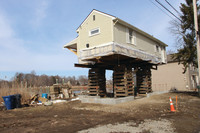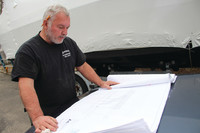By JOHN HOWELL Super Storm Sandy was the worst. Jeff Baris had been following the storm. He had lots on his mind. As the city's Harbormaster he was concerned of the storm's effects on the city's waterfront and how it would impact marinas and the many
This item is available in full to subscribers.
We have recently launched a new and improved website. To continue reading, you will need to either log into your subscriber account, or purchase a new subscription.
If you are a current print subscriber, you can set up a free website account by clicking here.
Otherwise, click here to view your options for subscribing.
Please log in to continue |
|


Super Storm Sandy was the worst.
Jeff Baris had been following the storm. He had lots on his mind. As the city’s Harbormaster he was concerned of the storm’s effects on the city’s waterfront and how it would impact marinas and the many boats moored along its 39-mile coastline. On a personal level and owner of a small home on Harris Avenue, which is on Warwick Cove, he wondered what the storm surge would mean for him.
Since living there he had been flooded by three other storms. The first was Hurricane Bob in 1991. His flood insurance covered damages, but he lived under that persistent threat of another storm and being flooded once again.
He rode out Sandy at the property. At the height of the storm surge, the water was knee-deep in his kitchen and living room.
That’s not likely to happen again and if it does, much of Warwick will be under water.
Baris’ home is moving up, the first in Warwick to be elevated under a federally financed program made available to homeowners that have experienced multiple flood losses.
“There’s going to be a lot less wet feet exercise,” he said laughing. On the other hand, he’s going to be doing a lot of climbing. The 600-square foot house has been more than 11 feet above mean sea level and above the AE 12 flood zone where it is located.
“It’s kind of like moving a tool shed,” Baris said of his home.
That’s not the way Charles Frigon, owner of Seaside Builders of Warwick and general contractor on the job sees it. While five contractors showed an interest in the project when advertised by the city, Frigon was the only one to submit a bid. Baris is bound to pay for the work, which is reimbursed by the federal grant program. But because Federal Emergency Management Agency funding flows through the city, Warwick must follow its bidding protocols even though no city funds go to the project.
Frigon subcontracted elevation of the house to Reggie Cooper at Aquidneck Island Dry Wall and Builders. Contractor Jim Cesario of Warwick followed up with the site work that required digging out the former cement building pad and replacing mushy earth with crushed stone, and building 22 footings that served as the foundation for concrete walls erected by O’Brien Forms. Frigon’s crews will finish off the work that includes electrical, plumbing and the stairs to reach the house.
The $125,700 contract is restricted to work needed to elevate the house, explains William Fascente, city housing officer. If Baris wants to add to the house while the work is being done, those costs are up to him.
Getting this far hasn’t come easily.
Facente learned of programs to elevate flood prone properties in 2014. Knowing that coastal flooding and the escalating cost of flood insurance is a significant problem in the city, he advertised the program and set out letters to homeowners. The Hazard Mitigation Grant Program paid for 75 percent of the cost, but although there were a few inquiries no homeowners went through the formal application process. Then came along the 100 percent reimbursement program for those homeowners with repetitive losses. Letters went out to six homeowners. Baris was one of two to respond. Although it appeared the second homeowner was eligible, Fascente said he chose not to apply.
Work on Baris’ home started on Jan. 19. He has been staying at the home of a friend in Cranston who is away for the winter months.
In order to make it all happen and cover unforeseen expenses he’s certain will occur, Baris dipped into his retirement account to come up with the cash. With good weather, he expects to be back in his home with an all-new view of Warwick Cove this spring.
“It’s a great program,” Baris said, “it unlikely they’ll ever have to pay another flood claim.”
And on the topic of flood insurance – Baris is now paying a $2,000 premium – he’s hopeful that will come down significantly. After all, at some time the house may be surrounded by water, but high and dry above the flood zone.
Facente said he has received inquiries since the Baris project was approved. He said there is generally a narrow window of a couple of weeks to apply for grants when they become available. He plans to notify those who have expressed an interest as well as advertise the grants when grants are announced.
2 comments on this item Please log in to comment by clicking here
richardcorrente
In the last year or so flood insurance has come down in cost as more companies are entering the market. Google "low cost flood insurance" to see if you can reduce yours.
Even Lloyds of London, traditionally an expensive insurer, has entered the market with a premium that is oftentimes the lowest.
Check around. It will be worth the effort.
Happy Spring everyone.
Rick Corrente
The Taxpayers Mayor
Thursday, March 9, 2017 Report this
RIvoter
Why are we even bothering to do this. The current administration keeps assuring us this is a hoax and that all funding for for these programs will soon disappear. The funding for both the NASA and NOAA are about to be cut off. There will be no more climate tracking or weather services. FEMA will no longer respond to disasters until the costs are over $2 billion. We are on our own now!
By ignoring it, it doesn't exist. Let's all bury our heads in the sand and learn how to drink toxic water and breathe smog.
Friday, March 10, 2017 Report this